Antarctic fisheries catch thousands of tonnes of krill each year, and large krill predators such as whales are recovering from heavy harvest. Meanwhile, chinstrap penguins, which depend on krill, have become markedly fewer. Understanding the cause of this decline is critical.
This article was first published in Fram Forum 2024.
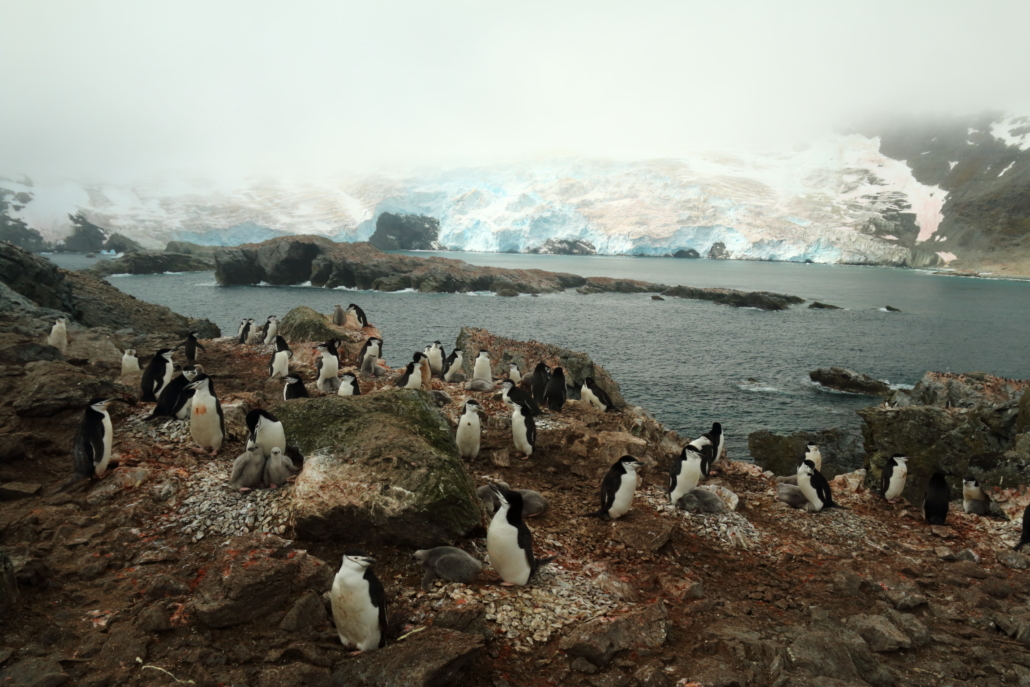
Penguins at a nesting site on Monroe Island off Coronation Island in the South Orkney Islands archipelago. Photo: Chris Oosthuizen, University of Cape Town.
In the Antarctic, the largest volume fishery is that for Antarctic krill, with a current annual total of about 450,000 tonnes caught near the Antarctic Peninsula in the Scotia Sea. Norwegian vessels take over 60% of this total, primarily for use in aquaculture feed and to extract krill oil for nutritional supplements.
The krill fishery is managed under the Convention on the Conservation of Antarctic Marine Living Resources (CCAMLR) and supported by a Scientific Committee that provides science-based advice to set sustainable harvest levels. Since 1991 CCAMLR has had in place a precautionary catch limit of 620,000 tonnes, representing about 10% of the estimated sustainable yield and 1% of the estimated standing stock in the Scotia Sea.
CCAMLR has determined that any future increases in catch must be science-driven and sustainable. However, its Environmental Monitoring Programme (CEMP), developed in the late 1980s, is outdated and unable to attribute causation of ecosystem change to either climate change, fishing pressure or both. Here, we present two active research programmes led by Norway that aim to develop modern ecosystem monitoring methods and shed light on possible drivers of the recently observed steep decline in chinstrap penguin populations.
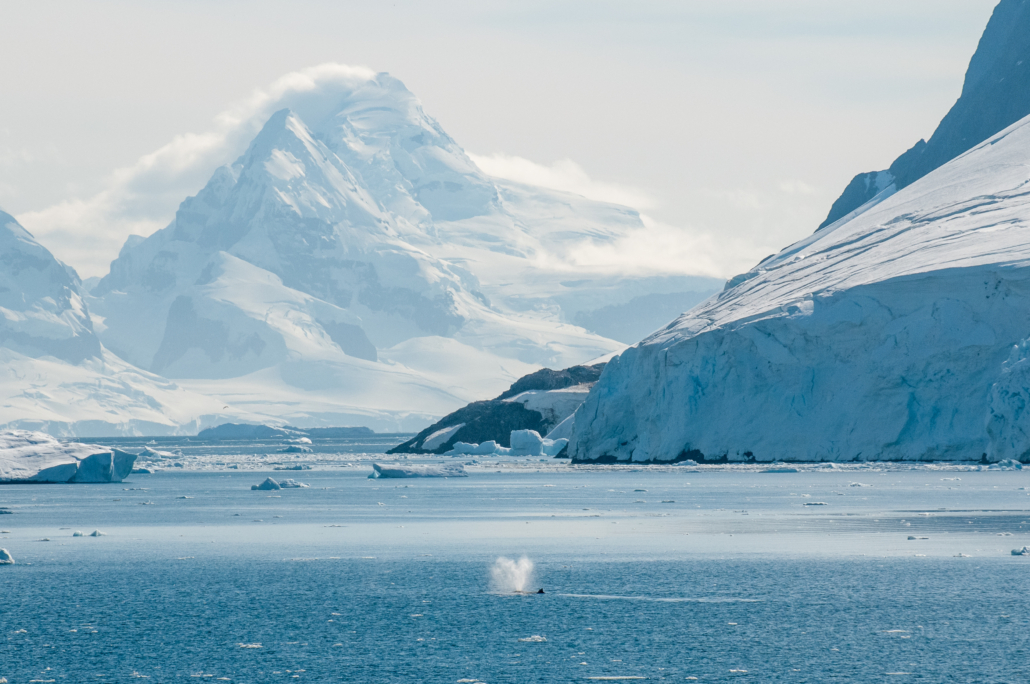
Humpback whale spouting in Gerlache Strait, Antarctic Peninsula. Photo: Elling Johannessen, Norwegian Polar Institute.
Do more whales mean fewer penguins?
Surveying the abundance and distribution of whales in the Antarctic is costly and logistically challenging, and often results in a single point estimate in time. We make use of cruise ships that support the large tourist industry operating throughout the Antarctic Peninsula between November and March each year as platforms of opportunity. Trained observers conduct standardised observations throughout the Antarctic summer. These observations, combined with model-based analyses, can estimate abundance, distribution, and species composition of whales in the region. Because cruise ships repeatedly follow regularly scheduled routes, using these platforms also allows us to characterise how whale abundance and distribution changes over the summer months.
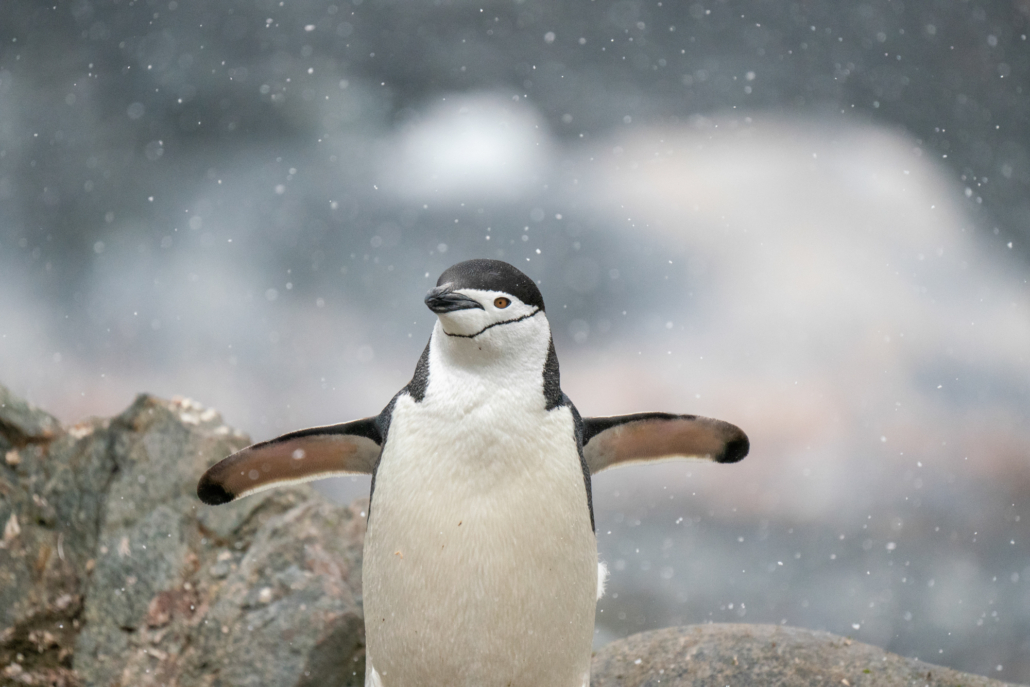
Chinstrap penguin Photo: Elling Deehr Johannessen
During the summer breeding season, chinstrap penguins make short trips to sea to catch krill, returning to land to feed their chicks at regular intervals, thus limiting how far and for how long parents can travel to forage. To help better understand why chinstrap penguin populations were in decline, in 2019 Norway led the largest penguin tracking programme ever performed in the Antarctic Peninsula. Three field teams simultaneously instrumented hundreds of penguins at three separate locations, including two colonies that have shown high rates of decline, to determine where they fed at sea. One of the findings from this study was that the foraging distribution of these chinstrap penguin colonies did not overlap with the krill fishery during their breeding seasons, but that it overlapped extensively with that of whales.
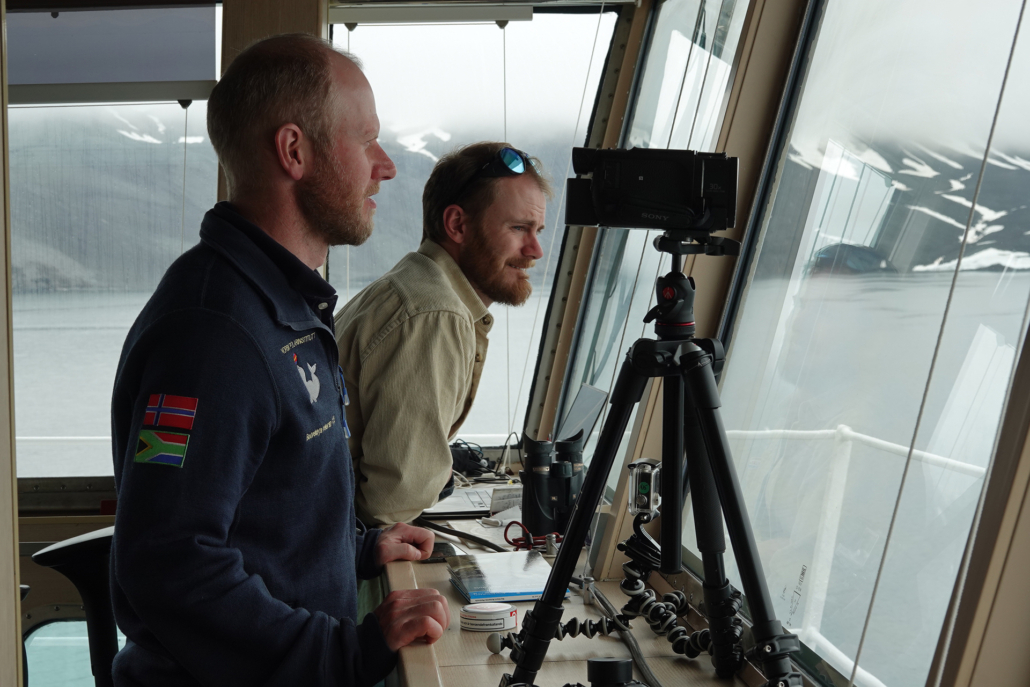
Observers on a cruise vessel looking out for whales. Photo: Camille Seaman, National Geographic Expeditions.
The spatial distribution of the krill fishery is driven by many factors, including sea ice distribution and quota availability. This results in a predictable fishing pattern, with little or no krill harvest off the western Antarctic peninsula during the penguin breeding period (December–February). In contrast, our whale observations indicate substantial overlap between penguin foraging locations and the highest densities of humpback whales, a species that has undergone a dramatic recovery over the same period that the fishery has been operating. Surprisingly, competition with humpback whales is often not considered as a factor in the decline of chinstrap penguins.
Our research, now entering its fourth year of data collection, demonstrates that platforms of opportunity such as tourist ships can be used to obtain highly relevant information on krill predator dynamics and represent a cost-effective means to improve CEMP.
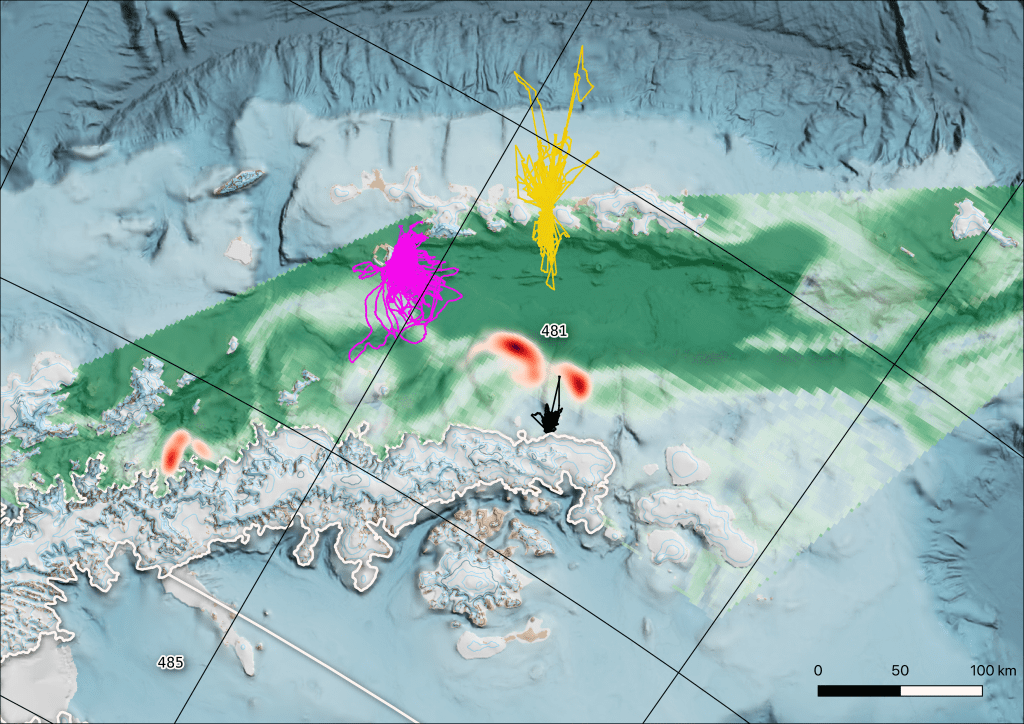
Along the Antarctic Peninsula, the krill fishery has recently centred around two areas (red shading). In 2019 a large multi-site penguin tracking project led by Norway was conducted to determine the degree of overlap between krill-eating penguins (Deception Island: pink lines, Nelson Island: yellow lines, Kopaitic Island: black lines) and the fishery. In addition, a novel monitoring programme using tourist vessels as opportunistic platforms for collecting data on the density and distribution of krill-eating baleen whales clearly shows complete overlap with the at-sea distribution of breeding penguins (humpback whale distribution and relative densities denoted by green shading). Map and graphics: Norwegian Polar Institute.
Penguins monitor ecosystems for us
While foraging chinstrap penguins and the krill fishery overlap little during the breeding season in the Antarctic Peninsula, they do overlap in space and time at the South Orkney Islands. Here, just under half of the total annual krill catch is concentrated in a pair of marine canyons 30 km west of Coronation Island. These canyons are within the foraging range of penguins breeding along the west coast of the island. There is no permanent research infrastructure here, and penguin population sizes near the key fishing grounds have not been updated since the late 1980s. This makes it incredibly difficult to conduct CEMP monitoring.
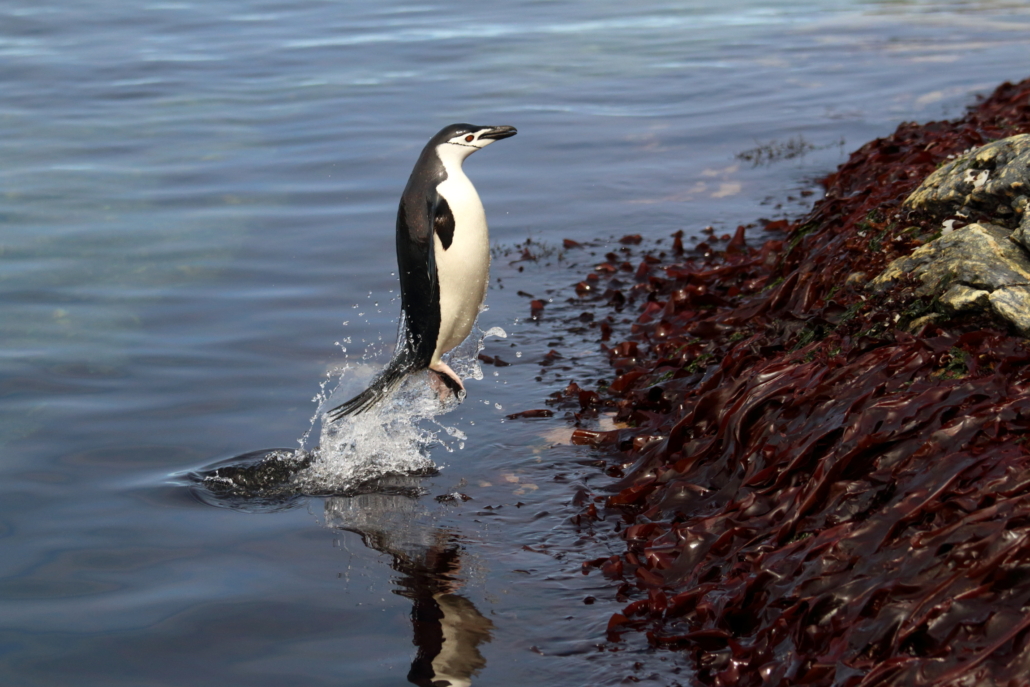
A chinstrap penguin returning to feed its young. Photo: Chris Oosthuizen, University of Cape Town.
Our second research programme specifically addresses these challenges, and aims to develop a monitoring index that minimises the need for human presence while being relevant enough to determine whether fishing activities are adversely impacting penguins. With knowledge of the location of fishing activity and the prevailing ocean currents, we selected two penguin colonies: one where adult birds foraging at sea are directly exposed to fishing activities (Monroe Island), and the other in an area that was not affected by fishing (Powell Island). At both locations, we instrumented penguins with miniaturised high resolution electronic tags (measuring GPS position, diving depth, and body acceleration) and animal-borne HD video cameras.
We were able to match krill feeding activities recorded by video to body acceleration data. Subsequently, implementing a machine learning algorithm, we can identify how often penguins catch krill at sea using body acceleration sensors only. This allows us to determine precisely how much krill individual penguins catch and under what conditions, using inexpensive tags that record body acceleration data. We are now able to develop a time series of penguin foraging performance with high enough resolution to determine the impacts of fishing against the backdrop of natural variation in krill abundance through changes in feeding rates.
The sustainable management of fishing is essential to ensure global food security; however, the conditions and remoteness of Antarctica, and the continual decline in governmental research funding, make it more challenging to provide science-based advice on sustainable ecosystem-based management of krill fisheries. Therefore, employing cutting-edge field and lab methods and collaborating with tourist and fishing industry partners will be crucial.
Further reading
Johannessen JED, Biuw M, Lindstrøm U, Ollus VMS, Martín López LM, Gkikopoulou KC, Oosthuizen WC, Lowther A (2022) Intra‐season variations in distribution and abundance of humpback whales in the West Antarctic Peninsula using cruise vessels as opportunistic platforms. Ecology and Evolution 12(2):e8571, doi: doi.org/10.1002/ece3.8571
Lowther AD, Staniland I, Lydersen C, Kovacs KM (2020) Male Antarctic fur seals: neglected food competitors of bioindicator species in the context of an increasing Antarctic krill fishery. Scientific reports 10(1):18436, doi: doi.org/10.1038/s41598-020-75148-9





